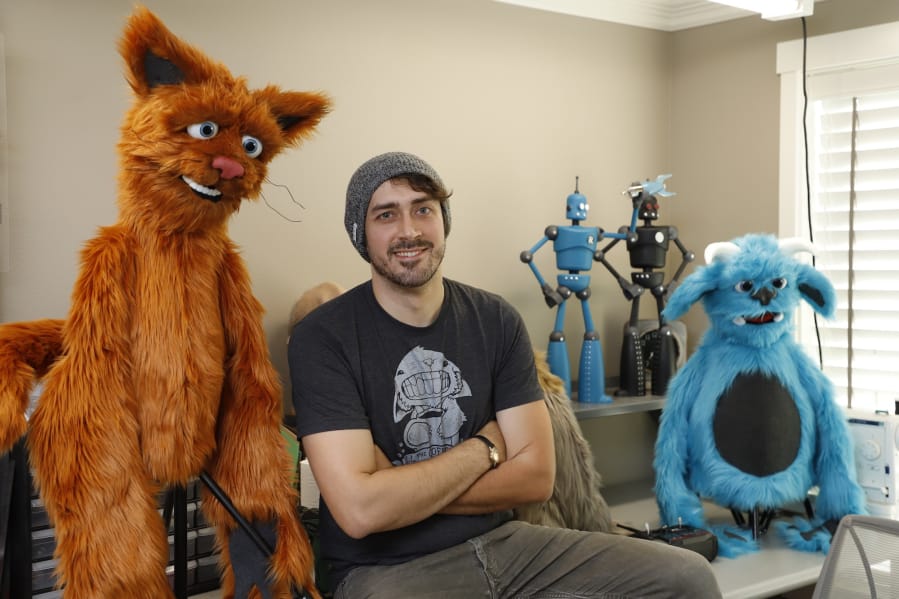There’s an animatronic teddy bear mounted on a pole that coughs every time it detects unsafe levels of pollution in London.
No, that sentence is not the outcome of a particularly weird round of Mad Libs. It’s the tale of Toxic Toby, an unlikely venture from Britain’s clean air activists and Battle Ground business Luna’s Puppets.
Using 3D printing and a background in machining and animatronics, puppet-maker Kevin Gorby brought the bear to life and turned Toxic Toby into a sympathetic face to advocate for cleaner air.
“This company came to us wanting to know if we would be able to build an animatronic bear. They had a pretty tall list of what they wanted this to be able to do, and a pretty short turnaround time,” Gorby said.
McCann London, an advertising agency, is using Toxic Toby as a tool in the fight to urge Britain’s lawmakers to pass a new Clean Air Act and treat access to clean air as a legally protected human right.
Set up to look like a memorial surrounded by flower bouquets, Toby is stationed along the busy streets in downtown London. He’s connected to an app called BreezoMeter that measures air quality around the world in real time.
When pollution rises over a certain threshold, he raises his fuzzy little hand to his fuzzy little face and lets out a pitiful cough.
It’s cute. More importantly, it’s hard to ignore.
According to McCann London, far more people die in the city every year as a result of air pollution than they do from traffic accidents — an estimated 9,400 fatalities compared to 211. They hope that the teddy bear gets the attention of passers-by, and the statistics do the rest.
“It catches everyone’s eye,” Gorby said. “The fact that it comes to life really has that shock factor to grab people’s attention and draw them in.”
How it works
From his Battle Ground workshop, Gorby constructed Toxic Toby out of 3D printed parts. The bear can turn his head, move his eyebrows, raise his arm and expand his chest to simulate breathing. It includes a built-in speaker for sound effects. While Luna’s Puppets had worked with 3D printers in the past to build prototypes of certain products, this was something else entirely.
“This is actually the first project that we did a complete, 3D-printed animatronic design,” Gorby said.
“The main reason for doing that is they plan on ordering a lot in the future as they spread this campaign, so each build has to be identical to the last,” he continued. “It also allowed him to be completely watertight, since they’re going to be outside in the U.K.”
Toxic Toby interfaces with the app BreezoMeter, which collects and reports air quality data from thousands of sensors worldwide, according to Julie Ach, the company’s content marketer.
BreezoMeter collects data from government monitoring stations and integrates that information with weather data, traffic information and airdispersion models.
“Air pollution is really dynamic, so if you’re on a small side street or a major thoroughfare, you’re going to be breathing different pollutants. Likewise, air pollution changes over time, as it dissipates, builds up, etc., depending on the geography, temperature, humidity, etc. There are a lot of parameters at play,” Ach wrote in an email to The Columbian.
In theory, you can use the app to measure pollution data anywhere in the world, down to the city block.
For instance, as of Monday afternoon, an interactive BreezoMeter map reports that the air quality at Gorby’s shop in Battle Ground has an air quality score of 74 on a scale of 1 to 100 — that’s good, but worth keeping an eye on. At Vancouver’s City Hall, the air quality was ranked at 71.
To contrast, downtown London had an air quality score of 58. In Beijing, BreezoMeter ranked the air quality at a 26.
“(You can) reduce one’s exposure to air pollution, but that’s more feasible when you know you’re exposed. Air pollution is often invisible,” Ach wrote. “But with accurate, relevant and intuitive data, we can help improve the lives and well being of people around the world.”
Looking forward
Technically, Toxic Toby can do more than just cough, according to Gorby. If McCann London decides to use the puppet for more, the bear has the capability to actually “converse” with people.
“We set it up with a bunch of different features,” Gorby said. “It has a live feed Bluetooth setup, so if you talk into the mic that’s connected to the Bluetooth the bear will interact in real time based off the audio.”
He’s now working with the ad agency to build more air-quality monitoring puppets, to station in cities around Europe and eventually the United States.
“Right now, they’re just unveiling it, and already the reaction it’s gotten and the coverage it’s gotten is beyond what we expected,” Gorby said.
“We’re excited to see where it goes, because it’s just going to keep blowing up.”
Gorby is no stranger to building animatronic puppets for campaigns — he’s been commissioned by brands to build mascots for use in advertising and marketing. But this is the first time his work has ventured into the political sphere, and he feels strongly about the cause.
He’s proud of the role Luna’s Puppets is playing to help educate people about pollution, he said.
“We’re pretty invested into climate change,” Gorby said. “We’ve been trying to figure out ways to get into that and make a difference ourselves.”




